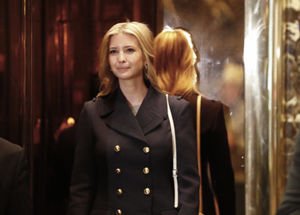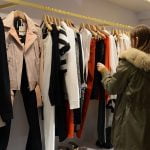
NEW YORK – If President-elect Donald Trump needs an object lesson on the difficulty of reviving broad sectors of U.S. manufacturing, he need look only as far as his daughter’s closet.
Ivanka Trump’s $100 million apparel line is sewn in Asian countries under a licensing agreement with G-III Apparel Group Inc., which has expanded from making coats in New York’s Garment District to become a manufacturer of global scope. That method of moving $140 sheath dresses and $80 sweaters means political embarrassment for her father, who has threatened a trade war against China, the world’s second-largest economy. But she can make a profit in few other ways.
Manufacturing apparel in the U.S. would be much more expensive, doubling the cost of goods, by some estimates. The nation no longer has the infrastructure for large-scale garment manufacturing or the labor force – much of which would be automated in any event.
“In the past 40 years we’ve done basically nothing but shut down all the production. It’s not so easy to ramp it up again,” said Marshal Cohen, chief industry analyst at NPD Group, a Port Washington, New York-based research firm. “We have interest in it, but we don’t act on it. The cost of putting it together is prohibitive.”
Donald Trump campaigned on soaring promises to revive U.S. manufacturing and bring jobs back from overseas, even negotiating directly with Carrier to preserve an Indianapolis plant that had been set to move to Mexico. He has vowed to renegotiate and even nullify trade agreements that he says disadvantage U.S. workers. Delivering won’t be easy, as evidenced by the fact that even his own Donald J. Trump collection of suits, ties, dress shirts and accessories is made overseas.
Manufacturing jobs in the U.S. have declined 37 percent since their peak in 1979. Cheap labor overseas has reduced costs for companies and trained consumers to expect low-priced goods. Only 16 years ago, the garment industry made 50 percent of U.S. apparel in the Western Hemisphere. Today, a mere 20 percent is produced in the Americas — and only 2 percent domestically, said Ed Gribbin, president of Alvanon, a New York-based apparel-consulting company.
The Ivanka Trump brand is interested in “being a part of the conversation” about increasing U.S. production, President Abigail Klem said in an e-mailed statement. She declined to comment further.
G-III, which does the brand’s physical work, exemplifies the way homegrown U.S. industry has moved jobs out of the country.
The company, whose representatives didn’t respond to requests for comment, was founded in 1956 by Aron Goldfarb, a Holocaust survivor who moved to New York from Israel and found a job cutting leather patterns. First called G&N, the company grew from a struggling operation making leather jackets to become the publicly traded G-III in 1989.
In the 1970s, G-III became one of the first apparel companies to import coats from South Korea. Chief Executive Officer Morris Goldfarb, son of the founder, expanded its manufacturing in Asia, according to a history on its website. In the 1990s, G-III started partnering with national brands that now include Jessica Simpson and Calvin Klein, which helped it place its clothes in department stores like Kohl’s Corp., Macy’s Inc. and Nordstrom Inc.
Four years ago, G-III announced its deal with Ivanka Trump’s IT Apparel II company to license her name on a line of dresses, activewear and underwear. Morris Goldfarb said at the time that the clothes would “capture the next generation of young, confident and sophisticated women.”
It would do so at a reasonable price.
The Trump clothes are sourced primarily from China and Vietnam because that’s where fabrics are made and the labor is cheap and skilled. The brand generates an estimated $100 million in sales — a small part of G-III’s annual take of more than $2 billion, said John Kernan, an analyst for Cowen & Co.
Donald Trump stoked anger at such outsourcing in an October speech in Greensboro, North Carolina, once home to large textile and furniture industries.
“They get the jobs, they get the factories, they get the cash, and all we get — we get illegal immigration and we get drugs,” he said in the speech. But dissonance persists between his public stances and the family’s private business.
Ivanka Trump has taken a small step to distance herself from her branding company: They now have separate Twitter accounts. Still, protesters gathered outside her New York City home this week for a candlelight vigil. Groups are organizing boycotts of retailers that sell her goods.
“All eyes are upon her, and soon, all eyes will be on her brand,” Cohen said. “She’s going to be put under a microscope, and any step she takes is going to be analyzed and scrutinized.”
Even if Ivanka Trump could persuade G-III to move all or part of its manufacturing to the U.S., it would dramatically increase the cost of her goods, Cohen said. And that could be a death knell.
“If you ask a person if they prefer to buy made in America, they’ll always say yes, but when it comes to shopping they don’t act that way,” Gribben said. “They want a bargain, they want a value, they want something that looks great. They never look at the label.”
[Source:-THE SUN CHRONICLE]






